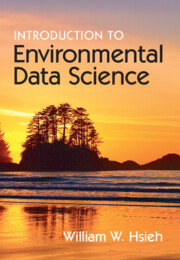Book contents
- Frontmatter
- Contents
- Preface
- Notation Used
- Abbreviations
- 1 Introduction
- 2 Basics
- 3 Probability Distributions
- 4 Statistical Inference
- 5 Linear Regression
- 6 Neural Networks
- 7 Non-linear Optimization
- 8 Learning and Generalization
- 9 Principal Components and Canonical Correlation
- 10 Unsupervised Learning
- 11 Time Series
- 12 Classification
- 13 Kernel Methods
- 14 Decision Trees, Random Forests and Boosting
- 15 Deep Learning
- 16 Forecast Verification and Post-processing
- 17 Merging of Machine Learning and Physics
- Appendices
- References
- Index
17 - Merging of Machine Learning and Physics
Published online by Cambridge University Press: 23 March 2023
- Frontmatter
- Contents
- Preface
- Notation Used
- Abbreviations
- 1 Introduction
- 2 Basics
- 3 Probability Distributions
- 4 Statistical Inference
- 5 Linear Regression
- 6 Neural Networks
- 7 Non-linear Optimization
- 8 Learning and Generalization
- 9 Principal Components and Canonical Correlation
- 10 Unsupervised Learning
- 11 Time Series
- 12 Classification
- 13 Kernel Methods
- 14 Decision Trees, Random Forests and Boosting
- 15 Deep Learning
- 16 Forecast Verification and Post-processing
- 17 Merging of Machine Learning and Physics
- Appendices
- References
- Index
Summary
Three areas where machine learning (ML) and physics have been merging: (a) Physical models can have computationally expensive components replaced by inexpensive ML models, giving rise to hybrid models. (b) In physics-informed machine learning, ML models can be solved satisfying the laws of physics (e.g. conservation of energy, mass, etc.) either approximately or exactly. (c) In forecasting, ML models can be combined with numerical/dynamical models under data assimilation.
Keywords
Information
- Type
- Chapter
- Information
- Introduction to Environmental Data Science , pp. 549 - 568Publisher: Cambridge University PressPrint publication year: 2023
